About
Underwater sound is an important feature for marine animals. Several species use sound to communicate for reproduction, feeding and navigation over a wide range of frequencies. Human activities add sounds in the aquatic environment. These activities include recreational and commercial navigation, off-shore exploration and developments and fisheries. Much of the technology contributing to ocean noise is new and in many cases the sounds generated are very different to natural sounds, both in their amplitudes and characteristics.
The SoundWaves Research Consortium has been formed with the specific intention of concentrating recognised UK expertise on the impact of man made underwater noise into a single team.
The consortium aims to understand how individuals and populations respond to changing environments in relation to increasing anthropogenic noise levels.
What is the Problem?
UK’s marine environment provides habitat for a rich marine community. We have the obligation to ensure its conservation and uses. Underwater noise in the sea is increasing. Shipping, offshore construction, dredging, seismic surveying for gas and oil and other activities are leading to higher levels of ambient noise. The effects of this additional noise upon marine life are poorly understood. At one extreme, the high level impulsive sounds from pile driving may kill or injure animals. Other sounds may result in animals leaving a preferred area. Sustained noise may affect the ability of animals to detect their own calls, or the sounds of predators or prey. To protect and ensure the continuing presence of a rich diversity of fauna in our territorial seas research is needed on the potentially adverse effects of underwater sound upon marine fauna This project will address this need and help ensure that the ecological status of our seas is not impaired by our noisy activities.
What are the aims of this project?
The overarching aim of this project is to provide an evidence-based tool to forecast effects of anthropogenic noise on marine animals. It will use state-of-the-the-art methods and a range of expertise within a multidisciplinary framework. The project is intended to achieve this aim by meeting the following five objectives:
- To review marine sound pollution with specific references to noise levels in connection with known effects on marine biota and especially fish and crustaceans.
- To develop ways of describing more precisely the characteristics of a range of noise polluting activities.
- To apply underwater observation methods to produce experimental evidence on the response of wild, naive fish to noise exposure sources under natural conditions in the sea.
- To define those exposure levels which lead to significant biological responses (injury, avoidance behaviour, startle responses).
- To produce evidence on any significant impacts of underwater noise and how these might be reduced or eliminated.




